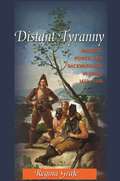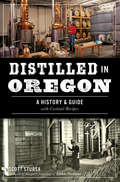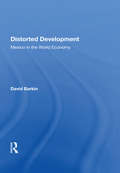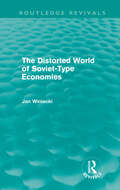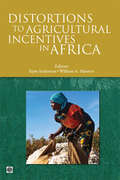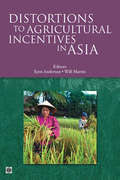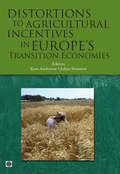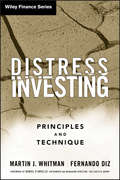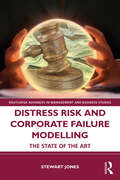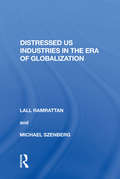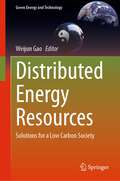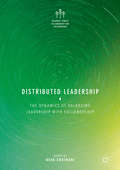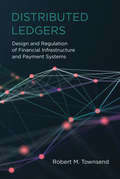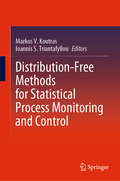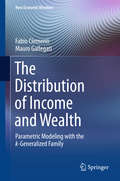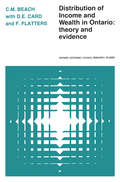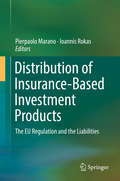- Table View
- List View
Distant Tyranny: Markets, Power, and Backwardness in Spain, 1650-1800 (The Princeton Economic History of the Western World #38)
by Regina GrafeSpain's development from a premodern society into a modern unified nation-state with an integrated economy was painfully slow and varied widely by region. Economic historians have long argued that high internal transportation costs limited domestic market integration, while at the same time the Castilian capital city of Madrid drew resources from surrounding Spanish regions as it pursued its quest for centralization. According to this view, powerful Madrid thwarted trade over large geographic distances by destroying an integrated network of manufacturing towns in the Spanish interior. Challenging this long-held view, Regina Grafe argues that decentralization, not a strong and powerful Madrid, is to blame for Spain's slow march to modernity. Through a groundbreaking analysis of the market for bacalao--dried and salted codfish that was a transatlantic commodity and staple food during this period--Grafe shows how peripheral historic territories and powerful interior towns obstructed Spain's economic development through jurisdictional obstacles to trade, which exacerbated already high transport costs. She reveals how the early phases of globalization made these regions much more externally focused, and how coastal elites that were engaged in trade outside Spain sought to sustain their positions of power in relation to Madrid. Distant Tyranny offers a needed reassessment of the haphazard and regionally diverse process of state formation and market integration in early modern Spain, showing how local and regional agency paradoxically led to legitimate governance but economic backwardness.
Distilled in Oregon: A History & Guide with Cocktail Recipes (American Palate)
by Foreword By Portland Scott StursaEarly Oregon fur traders concocted a type of distilled beverage known as �Blue Ruin,� used in commerce with local Native Americans. Drawn by the abundant summer harvests of the Willamette Valley, distillers put down roots in the nineteenth century. Because of Oregon�s early sunset on legal liquor production in 1916�four years before national Prohibition�hundreds of illicit stills popped up across the state. Residents of Portland remained well supplied, thanks to the infamous efforts of Mayor George Baker. The failed national experiment ended in 1933, and Hood River Distillers resurrected the sensible enterprise of turning surplus fruit into brandy in 1934. Thanks in part to the renowned Clear Creek Distillery triggering a craft distilling movement in 1985, the state now boasts seventy distilleries and counting. Author Scott Stursa leads a journey through the history of distilling in the Beaver State.
Distilled in Washington: A History (American Palate)
by Becky GarrisonStories to SavorWashington has a tortured history with liquor. Efforts to ban or restrict it date back to1854, before the region even attained statehood, with blue laws remaining on the books well into the twentieth century. From Jimmie Durkin, an enterprising saloon owner, to Roy Olmstead, a former Seattle cop turned gentleman bootlegger, the business of liquor has inspired both trouble and innovation.Join author and journalist Becky Garrison as she traces the history of the barrel and the bottle from early settlement to the modern craft distilling boom in the Evergreen State.
The Distinction of Peace: A Social Analysis of Peacebuilding
by Catherine Goetze“Peacebuilding” serves as a catch-all term to describe efforts by an array of international organizations, nongovernmental organizations, and agencies of foreign states to restore or construct a peaceful society in the wake—or even in the midst—of conflict. Despite this variety, practitioners consider themselves members of a global profession. In The Distinction of Peace, Catherine Goetze investigates the genesis of peacebuilding as a professional field of expertise since the 1960s, its increasing influence, and the ways it reflects global power structures. Goetze describes how the peacebuilding field came into being, how it defines who belongs to it and who does not, and what kind of group culture it has generated. Using an innovative methodology, she investigates the motivations of individuals who become peacebuilders, their professional trajectories and networks, and the “good peacebuilder” as an ideal. For many, working in peacebuilding in various ways—as an aid worker on the ground, as a lawyer at the United Nations, or as an academic in a think tank—has become not merely a livelihood, but also a form of participation in world politics. As a field, peacebuilding has developed techniques for incorporating and training new members, yet its internal politics also create the conditions of exclusion that often result in practical failures of the peacebuilding enterprise. By providing a critical account of the social mechanisms that make up the peacebuilding field, Goetze offers deep insights into the workings of Western domination and global inequalities.
Distorted Development: Mexico In The World Economy
by David BarkinThis book offers an analysis of some of Mexico's most pressing problems. It is designed to help the reader understand the underlying dynamic processes shaping Mexican society and the Mexican economy. The chapters present a vision of a common pattern of distorted development that assumes unique forms in different parts of economic and social life.
The Distorted World of Soviet-Type Economies (Routledge Revivals)
by Jan WinieckiThe Soviet Union and Eastern Europe provide unique examples of large-scale relatively highly developed centrally planned economies. In the 1980s economists in both the East and West began to focus with increasingly critical attention on the economies of the Soviet Bloc, in an attempt to explain why they were performing so poorly in comparison with the economies of the Western powers and the capitalist countries of South-East Asia. First published in 1988 this substantial and innovative contribution to the critical literature on the economies of the former Soviet bloc is unusual in that its author is equally familiar with both Western and Eastern sources. It highlights, in particular, a discrepancy between the behaviour of individuals in Soviet-style economies and that expected of agents in a market system. It proceeds to outline how the consequent discordance between microeconomic practice and macroeconomic planning generates fundamental economic distortions.
Distortions to Agricultural Incentives in Africa
by Kym Anderson William A. MastersThe vast majority of the world's poorest households depend on farming for their livelihoods. During the 1960s and 1970s, most developing countries imposed pro-urban and anti-agricultural policies, while many high-income countries restricted agricultural imports and subsidized their farmers. Both sets of policies inhibited economic growth and poverty alleviation in developing countries. Although progress has been made over the past two decades to reduce those policy biases, many trade- and welfare-reducing price distortions remain between agriculture and other sectors and within the agricultural sector of both rich and poor countries. Comprehensive empirical studies of the disarray in world agricultural markets appeared approximately 20 years ago. Since then, the Organisation for Economic Co-operation and Development has provided estimates each year of market distortions in high-income countries, but there have been no comparable estimates for the world's developing countries. This volume is the third in a series (other volumes cover Asia, Europe's transition economies, and Latin America and the Caribbean) that not only fills that void for recent years but extends the estimates in a consistent and comparable way back in time-and provides analytical narratives for scores of countries that shed light on the evolving nature and extent of policy interventions over the past half-century. 'Distortions to Agricultural Incentives in Africa' provides an overview of the evolution of distortions to agricultural incentives caused by price and trade policies in the Arab Republic of Egypt plus 20 countries that account for about of 90 percent of Sub-Saharan Africa's population, farm households, agricultural output, and overall GDP. Sectoral, trade, and exchange rate policies in the region have changed greatly since the 1950s, and there have been substantial reforms since the 1980s. Nonetheless, numerous price distortions in this region remain, others have been added in recent years, and there has also been some backsliding, such as in Zimbabwe. The new empirical indicators in these country studies provide a strong evidence-based foundation for assessing the successes and failures of the past and for evaluating policy options for the years ahead.
Distortions to Agricultural Incentives in Asia
by Will Martin Kym AndersonThe vast majority of the world's poorest households depend on farming for their livelihoods. During the 1960s and 1970s, most developing countries imposed pro-urban and anti-agricultural policies, while many high-income countries restricted agricultural imports and subsidized their farmers. Both sets of policies inhibited economic growth and poverty alleviation in developing countries. Although progress has been made over the past two decades to reduce those policy biases, many trade- and welfare-reducing price distortions remain between agriculture and other sectors and within the agricultural sector of both rich and poor countries. Comprehensive empirical studies of the disarray in world agricultural markets appeared approximately 20 years ago. Since then, the Organisation for Economic Co-operation and Development had provided estimates each year of market distortions in high-income countries, but there have been no comparable estimates for the world's developing countries. This volume is the third in a series (other volumes cover Africa, Europe's transition economics, and Latin America and the Caribbean) that not only fills that void for recent years but extends the estimates in a consistent and comparable way back in time-and provides analytical narratives for scores of countries that shed light on the evolving nature and extent of policy interventions over the past half-century. 'Distortions to Agricultural Incentives in Asia' provides an overview of the evolution of distortions to agricultural incentives caused by price and trade policies in the 12 largest economies of East and South Asia. Together these countries constitute more than 95 percent of the region's population, agricultural output, and overall GDP. Sectoral, trade, and exchange rate policies in the region have changed greatly since the 1950s, and there have been substantial reforms since the 1980s, most notably in China and India. Nonetheless, numerous price distortions in this region remain and others have added in recent years. The new empirical indicators in these country studies provide a strong evidence-based foundation for assessing the successes and failures of the past and for evaluating policy options for the years ahead.
Distortions to Agricultural Incentives in Europe's Transition Economies
by Kym Anderson Johan SwinnenThe vast majority of the world's poorest households depend on farming for their livelihood. During the 1960s and 1970s, most developing countries imposed pro-urban and anti-agricultural policies, while many high-income countries restricted agricultural imports and subsidized their farmers. Both sets of policies inhibited economic growth and poverty alleviation in developing countries. Although progress has been made over the past two decades to reduce those policy biases, many trade- and welfare-reducing price distortions remain between agriculture and other sectors as well as within the agricultural sector of both rich and poor countries. Comprehensive empirical studies of the disarray in world agricultural markets first appeared approximately 20 years ago. Since then the OECD has provided estimates each year of market distortions in high-income countries, but there has been no comparable estimates for the world's developing countries. This volume is the first in a series (other volumes cover Africa, Asia, and Latin America) that not only fill that void for recent years but extend the estimates in a consistent and comparable way back in time--and provide analytical narratives for scores of countries that shed light on the evolving nature and extent of policy interventions over the past half-century. 'Distortions to Agricultural Incentives in Europe's Transition Economies' provides an overview of the evolution of distortions to agricultural incentives caused by price and trade policies in the economies of Eastern Europe and Central Asia that are transitioning away from central planning. The book includes country and subregional studies of the ten transition economies of Central and Eastern Europe that joined the European Union in 2004 or 2007, of seven other large member countries of the Commonwealth of Independent States, and of Turkey. Together these countries comprise over 90 percent of the Europe and Central Asia region's population and GDP. Sectoral, trade, and exchange rate policies in the region have changed greatly since the dissolution of the Soviet Union in 1991, but price distortions remain. The new empirical indicators in these country studies provide a strong evidence-based foundation for evaluating policy options in the years ahead.
Distortions to Agricultural Incentives in Latin America
by Kym Anderson Alberto ValdesThe vast majority of the world's poorest households depend on farming for their livelihood. During the 1960s and 1970s, most developing countries imposed pro-urban and anti-agricultural policies, while many high-income countries restricted agricultural imports and subsidized their farmers. Both sets of policies inhibited economic growth and poverty alleviation in developing countries. Although progress has been made over the past two decades to reduce those policy biases, many trade- and welfare-reducing price distortions remain between agriculture and other sectors as well as within the agricultural sector of both rich and poor countries. Comprehensive empirical studies of the disarray in world agricultural markets first appeared approximately 20 years ago. Since then the OECD has provided estimates each year of market distortions in high-income countries, but there has been no comparable estimates for the world's developing countries. This volume is the second in a series (other volumes cover Africa, Asia, and Europe's transition economies) that not only fills that void for recent years but extends the estimates in a consistent and comparable way back in time-and provides analytical narratives for scores of countries that shed light on the evolving nature and extent of policy interventions over the past half-century. 'Distortions to Agricultural Incentives in Latin America' provides an overview of the evolution of distortions to agricultural incentives caused by price and trade policies in the economies of South America, plus the Dominican Republic, Nicaragua, and Mexico. Together these countries constitute about 80 percent of the region's population, agricultural output, and overall GDP. Sectoral, trade, and exchange rate policies in the region have changed greatly since the 1950s, and there have been substantial reforms, especially in the 1980s. Nonetheless, numerous price distortions in this region remain, others have been added, and there have even been some policy reversals in recent years. The new empirical indicators in these country studies provide a strong evidence-based foundation for assessing the successes and failures of the past and for evaluating policy options for the years ahead.
Distress Investing
by Whitman Martin J. Diz Fernando D'Aniello DanielPraise for Distress Investing "Marty Whitman has distilled decades of distressed investing experience into a text that is a must-read for everyone interested in the field, whether a student or a professional investor. " -Wilbur L. Ross, Chairman and CEO, WL Ross & Co. LLC "Distress Investing: Principles and Technique represents a detailed and unique perspective on an arcane arena of investment that is going to get a lot more attention. Marty Whitman is the master, and has set the standard for many years. " -Sam Zell, Chairman, Equity Group Investments, LLC "Martin Whitman and Professor Diz have produced a seminal work on the ins and outs of distressed investing for all distressed debt investors. It is jam-packed with information and guidance for the novice and the experienced. A must-read for anyone interested in distressed investing. " -Lewis Kruger, Stroock & Stroock & Lavan LLP "Marty Whitman, a legend in distress investing, packs decades of experience into these pages. The restructuring of the capital markets currently under way is sure to provide great distress investment opportunities, which this guide book can make count for you. " -Bruce Flatt, Brookfield Asset Management Inc. "The principles found in this book are those I used in the reorganization of my business from bankruptcy to an S&P 500 company with an investment grade rating and a multibillion-dollar market capitalization. An excellent premier by Marty Whitman and Professor Diz, integrating economic theory with real-world investment to help investors of all shapes and sizes understand and invest in distressed securities. " -Gene Isenberg, Chairman and CEO, Nabors Industries, Inc. "Marty Whitman, the unquestioned 'Dean' of active distressed investors, and Fernando Diz, one of the few academics specializing in distressed investing, have teamed up to provide perhaps the best and most comprehensive primer on distressed securities and markets. I learned so much from this remarkable volume. " -Edward I. Altman, Max L. Heine Professor of Finance, NYU Stern School of Business, Director of credit and debt markets research at the NYU Salomon Center and adviser to several financial institutions including, Paulson & Co. and Concordia Advisers
Distress Risk and Corporate Failure Modelling: The State of the Art (Routledge Advances in Management and Business Studies)
by Stewart JonesThis book is an introduction text to distress risk and corporate failure modelling techniques. It illustrates how to apply a wide range of corporate bankruptcy prediction models and, in turn, highlights their strengths and limitations under different circumstances. It also conceptualises the role and function of different classifiers in terms of a trade-off between model flexibility and interpretability. Jones's illustrations and applications are based on actual company failure data and samples. Its practical and lucid presentation of basic concepts covers various statistical learning approaches, including machine learning, which has come into prominence in recent years. The material covered will help readers better understand a broad range of statistical learning models, ranging from relatively simple techniques, such as linear discriminant analysis, to state-of-the-art machine learning methods, such as gradient boosting machines, adaptive boosting, random forests, and deep learning. The book’s comprehensive review and use of real-life data will make this a valuable, easy-to-read text for researchers, academics, institutions, and professionals who make use of distress risk and corporate failure forecasts.
Distressed US Industries in the Era of Globalization
by Lall RamrattanThis book presents analyses of several distressed industries in the United States, including the steel, footwear, textile and apparel, paper and publishing, and automobile industries. It particular, it focuses on the influence of the new era of globalization on these industries, as the authors argue that the transition to their current distressed states was triggered by the structural changes that resulted from globalization. While the inevitability of the negative impact of globalization may lead some to neglect research of distressed industries, these industries continue to survive and productively contribute to the economic base of the United States. Their stories are about the changing structure, conduct, and performance of the industrial United States.
Distributed Energy Resources: Solutions for a Low Carbon Society (Green Energy and Technology)
by Weijun GaoThe future of the distributed energy generation market is promising, with opportunities in the residential, commercial, and industrial sectors driven by increasing awareness of clean energy, greenhouse gas (GHG) emission reduction targets, and rising global demand for energy. This book focuses on UN Sustainable Development Goal 7, which aims to "ensure access to affordable, reliable, sustainable, and modern energy for all." It provides research results, applications, and case studies on the potential of distributed energy resources as a solution to building a low-carbon society. Coverage includes modeling and evaluation of distributed power systems, system maintenance and reliability, economic potential and implications of hydrogen energy systems, grid stabilization and carbon emission reduction, smart design, and the impact of energy penetration on public power grids. Case studies include the effects of renewable energy policies on solar photovoltaic energy in China, Germany, Japan, and the United States of America and a feasibility assessment of distributed energy systems in Shanghai. Distributed Energy Resources: Solutions for a Low Carbon Society will be a valuable resource for postgraduate students and researchers in energy systems, urban energy management, and renewable energy technologies and a reference guide for practicing engineers, urban energy planners, and energy system managers.
Distributed Leadership
by Neha ChatwaniAddressing the area of shared leadership, also known as collective or distributed leadership, this edited book embraces the underlying idea that leadership is a dynamic process that intersects closely with followership. While some authors present rigorously researched qualitative and quantitative case studies that investigate the dynamics of followership in distributive leadership in terms of collective decision-making, leadership identity, roles and demographic composition of groups in a variety of settings, other authors take a critical look at distributed leadership models by viewing them through the lens of nature and ecosystems as well as human development processes. The chapters aim to inspire readers to challenge the current definition of leadership and explore more inclusive and holistic paradigms. Distributed Leadership provides a comprehensive and constructive contribution to the field of leadership and will be an essential read for academics and scholar-practitioners interested in business management.
Distributed Leadership and Digital Innovation: The Argument For Couple Leadership (Routledge Focus on Business and Management)
by Caterina ManiscalcoWhen it comes to digital innovation, much research has been done with regard to the optimization of teams, but little attention has been given to leadership structures. This book presents a comprehensive research background on innovation leadership and its evolution over the years, examining how it has been shown to reflect the thinking needed today for organizations to succeed. This timely book proposes a refreshing and contemporary perspective on leadership that aims to address many of the challenges that leaders in digital innovation are faced with every day. With insights and experiences from other digital innovation leaders, as well as an auto-ethnographical case study, it will be of value to researchers, academics, practitioners, and students with an interest in leadership, innovation management, digital innovation, organization studies, and organizational psychology. Additional Information can be found at https://www.caterinamaniscalco.com/
Distributed Ledgers: Design and Regulation of Financial Infrastructure and Payment Systems
by Robert M. TownsendAn economic analysis of what distributed ledgers can do, examining key components and discussing applications in both developed and emerging market economies.Distributed ledger technology (DLT) has the potential to transform economic organization and financial structure. In this book, Robert Townsend steps back from the hype and controversy surrounding DLT (and the related, but not synonymous, innovations of blockchain and Bitcoin) to offer an economic analysis of what distributed ledgers can do. Townsend examines the key components of distributed ledgers, discussing, evaluating, and illustrating each in the context of historical and contemporary economics, and reviewing featured applications in both developed economies and emerging-market countries.
Distributed Serverless Architectures on AWS: Design and Implement Serverless Architectures
by Jithin Jude PaulExplore the serverless world using Amazon Web Services (AWS) and develop various architectures, including those for event-driven and disaster recovery designs. This book will give you an understanding of different distributed serverless architectures and how to build them using AWS components. You will begin with an introduction to serverless components and architectures, before progressing to data platforms and containers. Next, you'll dig deeper into these serverless architectures and how they leverage AWS components through practical use cases. You will also explore designing systems in a multi-cloud paradigm. Author Jithin Jude Paul then demonstrates how efficient serverless architectures are, and the benefits of designing distributed systems globally in a cost-effective way while incorporating a microservices architectural style. Distributed Serverless Architectures with AWS concludes with a discussion of current and future trends in serverless frameworks. After completing this book, you'll be able to design distributed serverless architectures using AWS.What You'll LearnGain an overview of different serverless architectures Design and build distributed systems using serverless componentsBuild serverless data and container platforms on AWSPlan a multi-cloud strategy using serverless components Who This Book Is For Cloud engineers, DevOps engineers, and architects focused on the AWS ecosystem, as well as software engineers/developers working with AWS.
Distribution: Changing Times-Winning in China
by Jimmy Hexter Jonathan WoetzelGetting products to new markets in China efficiently and cost-effectively is probably the most perplexing challenge multinational companies face as they expand from the big eastern cities into wider circles of smaller-tier cities. Getting the right distribution and sales operating model in place is a critical determinant of success.
Distribution at American Airlines (C)
by Benjamin EdelmanPresents 2011-2012 updates to American's distribution strategy including new challenges and disputes. [Supplement for case 909035]
Distribution-Free Methods for Statistical Process Monitoring and Control
by Markos V. Koutras Ioannis S. TriantafyllouThis book explores nonparametric statistical process control. It provides an up-to-date overview of nonparametric Shewhart-type univariate control charts, and reviews the recent literature on nonparametric charts, particularly multivariate schemes. Further, it discusses observations tied to the monitored population quantile, focusing on the Shewhart Sign chart. The book also addresses the issue of practically assuming the normality and the independence when a process is statistically monitored, and examines in detail change-point analysis-based distribution-free control charts designed for Phase I applications. Moreover, it introduces six distribution-free EWMA schemes for simultaneously monitoring the location and scale parameters of a univariate continuous process, and establishes two nonparametric Shewhart-type control charts based on order statistics with signaling runs-type rules. Lastly, the book proposes novel and effective method for early disease detection.
The Distribution of Income and Wealth
by Fabio Clementi Mauro GallegatiThis book presents a systematic overview of cutting-edge research in the field of parametric modeling of personal income and wealth distribution, which allows one to represent how income/wealth is distributed within a given population. The estimated parameters may be used to gain insights into the causes of the evolution of income/wealth distribution over time, or to interpret the differences between distributions across countries. Moreover, once a given parametric model has been fitted to a data set, one can straightforwardly compute inequality and poverty measures. Finally, estimated parameters may be used in empirical modeling of the impact of macroeconomic conditions on the evolution of personal income/wealth distribution. In reviewing the state of the art in the field, the authors provide a thorough discussion of parametric models belonging to the "κ-generalized" family, a new and fruitful set of statistical models for the size distribution of income and wealth that they have developed over several years of collaborative and multidisciplinary research. This book will be of interest to all who share the belief that problems of income and wealth distribution merit detailed conceptual and methodological attention.
Distribution of Income and Wealth in Ontario: Theory and Evidence
by Charles M. Beach David E. Card Frank FlattersDistribution analysis has advanced remarkably in recent years, and this is a valuable application of its principles to a Canadian context. The book provides an extensive survey of recent literature and a new source of income and wealth distribution data for Ontario, drawn from newly available microdata sets. It also presents an evaluation of the data as a basis for measuring inequality in the distribution of economic and well-being.The empirical results illustrate how incomes vary significantly with age according to labour market attachment and experience, educational attainment and occupation, transfer receipts, and investment benefits. Similarly, strong age effects on net worth account reflect life-cycle patterns in asset holdings and debts typically associated with family investment in housing and financial adjustments for retirement. Differences in family size and composition have a substantial effect on the structure of family economic well-being. The inequality effects of adjusting for accrued capital gains and net worth holdings can also be quite significant. It is found that the distributional effects of CPP net benefits are considerable, although they are not as equalizing as one may have expected because of marked cohort effects. The detailed findings suggest that the life-cycle framework is a very useful one for evaluating the distributional effects of certain government programs, particularly intertemporal ones, and they underline the need for a range of different types of policies to address low income problems. The study urges greater recognition of the inequality of treatment and opportunity among different groups of the population. It also points out that conventional income distribution figures are only very imperfect estimates of the state of inequality in the underlying distribution of economic well-being.
Distribution of Insurance-Based Investment Products: The EU Regulation and the Liabilities
by Pierpaolo Marano Ioannis RokasThe book addresses a topic at the intersection of two heavily regulated sectors: insurance and investment services. Until recently, scholars and professionals have approached insurance and investment services as two separate categories in the financial services sector, and as being governed by separate regulatory frameworks. In practice, however, the boundaries were and are blurred, a reality that regulators have begun to recognize and address in their more recent regulatory texts. The first part of the book approaches the new standards applicable to investment products based on insurance: insurance-based investment products (IBIPs). These rules are harmonized across the EU. The rationale behind this new definition is provided, together with a description of these products’ limitations. The analysis addresses the new rules and explores the legal regime and relevant standards applicable to IBIPs. The organizational rules concerning the design and distribution of IBIPs are also examined, and the book highlights e.g. how these rules are inspired by the principles of conduct. In closing, the ADR systems are analysed, in order to ascertain whether or not they can offer an effective tool for settling disputes over these products. In turn, the second part focuses on the liability for distribution of IBIPs, which ranks as one of the most conspicuous and relatively new legal phenomena, but at the same time, represents an exceptionally important field of civil liability in today’s world. Liability is still regulated at the national level. Thus, the four largest life insurance markets in the EU are considered, along with the largest emerging market for life insurance. The chapters on national laws also consider whether, and if so, how the new harmonized rules on IBIPs are being combined with those already in force in the jurisdictions considered. The goal is to determine whether the new rules are likely to change the doctrine and case law approach to these products, or whether the European legislators’ choices have no real impact on the protection of clients.
